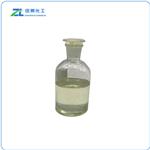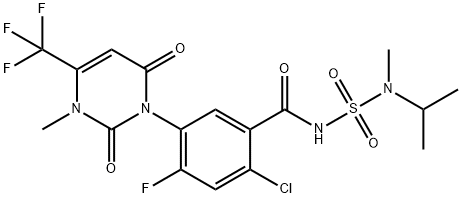- Saflufenacil
-

- $50.00 / 1kg
-
2025-01-10
- CAS:372137-35-4
- Min. Order: 1kg
- Purity: 99
- Supply Ability: 5000
Related articles - The toxicity of Saflufenacil
- Saflufenacil controls many common annual broadleaf weeds, including acetolactate synthase-resistant biotypes, by inhibiting pr....
- Jun 13����,2024
|
| | Saflufenacil Basic information |
| Product Name: | Saflufenacil | | Synonyms: | Saflufenacil;Saflufenacil@100 μg/mL in Methanol;Saflufenacil@1000 μg/mL in Acetonitrile;Benzamide, 2-chloro-5-[3,6-dihydro-3-methyl-2,6-dioxo-4-(trifluoromethyl)-1(2H)-pyrimidinyl]-4-fluoro-N-[[methyl(1-methylethyl)amino]sulfonyl]-;2-chloro-4-fluoro-5-[3-methyl-2,6-dioxo-4-(trifluoromethyl)-...;Kixor;Kixor Herbicide;Benzimidazole sulfonamide | | CAS: | 372137-35-4 | | MF: | C17H17ClF4N4O5S | | MW: | 500.85 | | EINECS: | | | Product Categories: | 372137-35-4 | | Mol File: | 372137-35-4.mol |  |
| | Saflufenacil Chemical Properties |
| density | 1.542±0.06 g/cm3(Predicted) | | solubility | DMSO ()Slightly, Methanol (Slightly) | | pka | 4.24±0.40(Predicted) | | BRN | 11326826 | | InChI | InChI=1S/C17H17ClF4N4O5S/c1-8(2)25(4)32(30,31)23-15(28)9-5-12(11(19)6-10(9)18)26-14(27)7-13(17(20,21)22)24(3)16(26)29/h5-8H,1-4H3,(H,23,28) | | InChIKey | GNHDVXLWBQYPJE-UHFFFAOYSA-N | | SMILES | C(NS(N(C)C(C)C)(=O)=O)(=O)C1=CC(N2C(=O)N(C)C(C(F)(F)F)=CC2=O)=C(F)C=C1Cl | | EPA Substance Registry System | Benzamide, 2-chloro-5-[3,6-dihydro-3-methyl-2,6-dioxo-4-(trifluoromethyl)-1(2H)-pyrimidinyl]-4-fluoro-N-[[methyl(1-methylethyl)amino]sulfonyl]- (372137-35-4) |
| Hazard Codes | N | | Risk Statements | 50/53 | | Safety Statements | 61 | | RIDADR | UN 3077 9 / PGIII | | WGK Germany | 2 |
| | Saflufenacil Usage And Synthesis |
| Uses | Saflufenacil-d7 is the labeled version of Saflufenacil (S081800), which is a herbicide of the pyrimidinedione chemical class used for the preplant burndown and selective preemergence dicot weed control in different field crops. It was found to inhibit protoporphyrinogen IX oxidase (PPO) enzyme. | | Definition | ChEBI: Saflufenacil is a member of the class of sulfamides that is sulfamide in which one of the amino groups has been substituted by a methyl group an an isopropyl group, while the other has been substituted by a 2-chloro-4-fluoro-5-[3-methyl-2,6-dioxo-4-(trifluoromethyl)-3,6-dihydropyrimidin-1(2H)-yl]benzoyl group. An important BASF herbicide, not registered in Europe but sold in USA, Canada and several other countries to control weeds in a wide range of food crops. Often mixed with other products such as glyphosate. It has a role as an EC 1.3.3.4 (protoporphyrinogen oxidase) inhibitor, a herbicide and an agrochemical. It is a member of monochlorobenzenes, a member of monofluorobenzenes and a member of sulfamides. It is functionally related to a uracil. | | Mode of action | Physiological and biochemical profiling confirmed that saflufenacil was a protoporphyrinogen-IX-oxidase (PPO) inhibitor. Saflufenacil elicits symptoms similar to other peroxidizing herbicides, including rapid, light-dependent necrosis of foliar tissue. Saflufenacil is readily absorbed by the root and shoot tissue of plants. Once absorbed, Saflufenacil is predominantly translocated via the xylem, with limited movement via the phloem. Saflufenacil is highly effective in controlling dicot weeds through contact and residual activity. In addition to non-crop and pre-plant burndown utility, saflufenacil demonstrates preemergence selectivity in a wide range of crops. Selectivity is conferred by physical placement and rapid metabolism of saflufenacil in tolerant crop species such as corn. |
| | Saflufenacil Preparation Products And Raw materials |
|